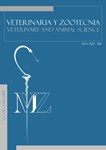Authors
Abstract
The third eyelid is an structure consisting of three components: glandular, conjunctive, and cartilaginous. The third eyelid gland is responsible for the production of about 50% of the precorneal film aqueous fraction. The third gland eyelid prolapse or “cherry eye” is the most common primary pathology on these patients third eyelid. The treatment is exclusively surgical, beginning in the gland exeresis to its reposition, being reccurence frequent. The aim of this paper is to establish the prevalence by breed, age and presentation (unilateral/bilateral) of third´s glands eyelid prolapse in dogs treated at the surgery area at the Veterinary Hospital “Diego Villegas Toro” of the Caldas University (Colombia) and a private veterinary Clinic in the city, between February and December, 2009. The small animals veterinary must be prepared to deal with such queries, considering that the management of the problems in the annex tissues will impact on the most sensitive structures such as the cornea.
References
Baungarten, L.B.; Eurides, D.; Busnardo, C.A.; Guimarães, E.C.; Alves, L.B.; Da Silva, L.A.F.; Daleck, C.R.; De Souza, L.A.; De Oliveira, B.J.N.A.; Golçalves, G.F. Avaliação da produção de lágrima em cães sem raçã definida após a exérese da glândula da terceira palpebra – estudo experimental. Revista Ceres, v.55, n.4, p.293- 296, 2008.
Brito, F.L.C.; Silva, V.A.; Maia, F.C.L.; Pereira, J.R.; Laus, J.L. Microalterations in the third eyelid gland of dogs with keratoconjuntivitis sicca secondary to distemper. Arquivo Brassileiro de Medicina Veterinaria e Zootecnia, v.59, n.2, p.340-344, 2007.
Blogg, JR. Diseases of the Eyelids. In: The Eye in Veterinary Practice: Extraocular Disease. Philadelphia: Saunders W. B; 1980: p. 342.
Cabral, V.P.; Laus, J.L.; Zaidan, M.L.; Pereira, G.T.; Talieri, I.C.; Monteiro, E.R.; Mamede, F.V. Canine lacrimal and third eyelid superficial gland’s macroscopic and morphometric characteristics (Canis familiares; LINNAEUS, 1758). Ciência Rural, v.35, n.2, p.391-397, 2005.
Cabral, V.P.; Watanabe, E.; Tostes, R.A.; Simonelli, S.M.; Laus, J.L. Protrusão da glândula da terceira pálpebra em cães. Proposta de um modelo experimental. Ciência Rural, v.38, n.7, p.1920- 1924, 2008.
Gelatt, KN. Manual de oftalmologia veterinária. São Paulo: Manole, 2003. 280p
Gross, SL. Effectiveness of a Modification of the Blogg technique for Replacing the Prolapsed Gland of the Third Eyelid. Proc. Am. Coll. Vet. Ophthalmol; vol. 14: p. 38 – 42, 1983.
Herrera, D. Enfermedades de los párpados. In: Herrera Daniel. Oftalmología clínica en animales de compañía. 1.Ed. Buenos Aires, Argentina: Ed. Intermédica, 2007. 104p.
Kaswan, RL; Martin, CL. Surgical correction of thirdeyelid prolapse in dogs. Journal of AmericanVeterinary Medical Association. vol.186, n.1:p.83, 1985.
Lackner, P.A. Techniques for Surgical Correction ofAdnexal Disease. Clinical Techniques in SmallAnimal Practice, v.16, n.1, p.40-50, 2001. W.B.Saunders Company.
Mazzucchelli, S.; Vaillant, M.D.; We’verberg, F.;Arnold-Tavernier, H.; Honegger, N.; Payen, G.;Vanore, M.; Liscoet, L.; Thomas, O.; Clerc, B.;.Chahory, S. Nictitans gland prolapse in dogs: aretrospective study of 155 cases (2001-2008).Abstracts: Annual Meeting of the EuropeanCollege of Veterinary Ophthalmologists/European Society of Veterinary Ophthalmologists,Copenhagen, Denmark, June 3-7, 2009.Veterinary Ophthalmology, American Collegeof Veterinary Ophthalmologists (ACVO), v.12,n.6, p.386-389, 2009.
Moore, CP; Frappier, BL; Linton, LL. Effects of twosurgical replacement techniques on excretory ducts of normal canine third eyelid glands.Proceedings of the American College ofVeterinary Ophthalmologists; vol. 25: p. 25,1994.
Morgan, RV; Duddy, JM; McClurg, K. Prolapse of thegland of the third eyelid in dogs: a retorspectivestudy of 89 cases (1980 to 1990). Journal ofthe American Animal Hospital Association,vol.29, n.1: p.56–60, 1993.
Peixoto, R.V.; Galera, P.D. Revisão de literatura:técnicas cirúrgicas para redução da protrusão daglândula da terceira pálpebra em cães. MedvepRevista Cientifica de Medicina VeterináriaPequenos Animais e Animais de Estimação,v.7, n.22, p.319-322, 2009.
Plummer, C.E.; Källberg, M.E.; Gelatt, K.N.; Gelatt,J.P.; Barrie, K.P.; Brooks, D.E. Intranictitanstacking for replacement of prolapsed glandof the third eyelid in dogs. Veterinary Ophthalmology, American College ofVeterinary Ophthalmologists (ACVO), v.11, n.4,p.228-233, 2008.
Slatter, D. Fundamentos de oftalmologiaveterinária. São Paulo: Roca, 2005. 686p.
Stanley, RG; Kaswan, RL. Modification of theOrbital Rim Anchorage Method for SurgicalReplacement of the Gland the third Eyelidsin Dogs. Journal of American Veterinary Medical Association, vol. 205, p. 1412 – 414,1994.
Umeda, Y.; Nakamura, S.; Fujiki, K.; Toshida,H.; Saito, A.; Murakami, A. Abstract No.:087 Globet cell MUC5AC MRNA in caninenictitanting membrane (2009). Abstracts: 40th Annual Meeting of the American Collegeof Veterinary Ophthalmologist, Chicago,IL, USA November 4-7, 2009. VeterinaryOphthalmology, American College of Veterinary Ophthalmologists (ACVO), v.12, n.6,p.390-409, 2009.
Wolf, ED. Abstract No.: 070 Cartilage reversal: atechnique for correction of everted nictitans.Abstracts: 40th Annual Meeting of the AmericanCollege of Veterinary Ophthalmologist,Chicago, IL, USA November 4-7, 2009.Veterinary Ophthalmology, American Collegeof Veterinary Ophthalmologists (ACVO), v.12,n.6, p.390-409, 2009.

 PDF (Español)
PDF (Español)
 FLIP
FLIP










